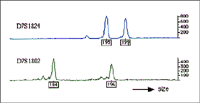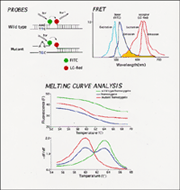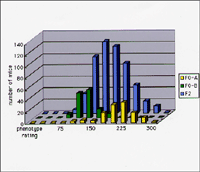 |

magnified
scene by clicking image
| Fig.1 |
Flow
chart of the positional approach |
|
Introduction
We have been conducting research on neuropsychiatric diseases. Disorders related
to the human brain or mind can be baffling to ordinary people and are sometimes
considered shameful, and people with these disorders are often avoided. This is
because these disorders influence mental activities and behaviors, and their causes
are not yet thoroughly understood. There have been few biological clues to understanding
the psychiatric diseases. In addition, sufficient funding for research has not
been available due to their low threat to human life compared to diseases such
as cancer and other physical disorders, except in the case of the risk of suicide.
Brain science is considered to be a significant issue of the next generation;
clarification of the mechanisms of psychiatric disorders is not only good news
for the patients, but will also lead to increased understanding of high-order
mental activities such as the formation of personality, thoughts and emotions.
Recent advances in various fields of neuroscience and astonishing developments
in the field of genome science have great potential to the research on psychiatric
disorders. In this article, we introduce our approaches to clarifying the mechanisms
of neuropsychiatric diseases following an outline of the history of research in
this field.
History
of the Research on Psychiatric Diseases
Psychiatric disorders
are classified into several categories based mainly on their symptoms and progression;
the two major types are schizophrenia and mood disorders
(bipolar disorder and depression), which are the topic of our research. Schizophrenia
usually develops in patients between puberty and the 30s, manifesting symptoms
such as

magnified
scene by clicking image
| Fig.2 |
An
example of microsatellite marker typing |
|
auditory hallucinations
and delusions of persecution, and/or exhibit excessive withdrawal tendencies and
autistic attitudes (examples are found in the novel "Norwegian Forest" by Haruki
Murakami, in which the symptoms of a heroine, Naoko, are described both subjectively
and objectively). Once it develops, schizophrenia often progresses chronically.
It is not an unusual disease, and is said to afflict one in 100 people worldwide,
regardless of geographical and cultural differences.
A drug effective for treating hallucinations and delusions (neuro-leptics) was
accidentally discovered in the 1950s. Analysis of its pharmacological action revealed
that the drug blocks the dopamine D2 receptor (dopamine is the neurotransmitter
which is also related to Parkinson' disease). Studies on dopamine neurotransmission
in patients have been carried out, but no conclusive results have been obtained.
Dopamine malfunction is probably not a direct cause of the disease, but may be
indirectly related to it. Mood disorders include bipolar disorder and depression;
patients with the former condition have periodic episodes of mania and depression,
and patients with the latter condition have periodical depression. These are also
not rare disorders, and patients develop these disorders in their 20s or 30s and
beyond. Drugs which improve symptoms of depression, tricyclic antidepressants
were discovered some time after the discovery of neuroleptics. Since the tricyclic
antidepressants block the uptake of monoamines (serotonin and noradrenaline; they
are neurotransmitters) from synaptic clefts, one hypothesis proposed that a decrease
in monoamine activity is a cause of depression, and various studies have been
performed along this line. However, the etiologies of mood disorders have not
yet been clarified.

magnified
scene by clicking image
| Fig.3 |
Typing
of DUSP6 gene missense mutation
using the FRET technology |
|
Molecular
Genetics Approach
The aim of our research
is to identify disease-related or susceptibility genes. The genetic involvement
in the development of schizophrenia and mood disorders is suggested by epidemiological
and other related studies. When no conclusive biological clues are available,
a positional approach as shown in Fig. 1 is an effective strategy to identify
genes related to the development of a disease. The steps are as follows: samples
from families in which these disorders are accumulated are collected, and typing
of microsatellite markers distributed throughout the chromosomes is performed
(Fig. 2). Then, mathematical/statistical analysis called linkage analysis is performed
to roughly determine the chromosomal regions on which the disease-causing genes
are located. With the cooperation of patients and their families, we have already
collected clinical data and DNAs from approximately 130 schizophrenic families
(total of approximately 400 individuals). We are currently typing the microsatellite
markers from all the chromosomes (whole genome scan). Concomitantly, we are typing
the other family panel, as part of a cooperative project on the nation-wide linkage
analysis of schizophrenia. Since the mathematical analysis methods of these two
projects have different advantages, we hope to obtain mutually beneficial and
integrating results. With regard to patients with mood disorders, the collection
of samples from affected families in Japan has not yet begun. But we have now
a candidate gene under analysis, which is located in the short arm of chromosome
18, a bipolar linkage region revealed by linkage analysis in the U.S. We are constructing
a genetically modified animal regarding this gene. Other methods have also been
employed including the candidate gene approach. Functional or positional candidate
genes on linkage loci are selected, and polymorphisms of these genes are identified
by mutation screening (in these cases, mostly single nucleotide polymorphisms
(SNPs)). Subsequently, an association analysis is performed regarding whether
or not the polymorphisms are significantly related to the disease development.
Some interesting polymorphisms are found from genes currently under analysis.
A rapid, accurate and inexpensive typing method is now in the stages of development
and improvement. We have attempted a fluorescence resonance energy transfer (FRET)
method and confirmed that the method is simple and reliable; therefore, we are
using the FRET method as one of the SNP typing (Fig. 3).
The strategy shown in Fig. 1 is especially an effective and established approach
for disorders with a simple Mendelian mode of inheritance. With respect to these
types of disorders, we are currently analysing a certain type of familial epilepsy
and a hereditary hearing loss.
Animal
Model
The use of animal models
for psychiatric disorders has a limitation in that brain functions of animals
and "mental activities" of human cannot be discussed on the same level. However,
with respect to depression, symptoms of depression can be determined by a decrease
in the activity level in animals; therefore, several types of models have been
used conventionally. Suppose that a mouse strain F0-A is highly sensitive to test
A and a mouse strain F0-B is not sensitive (resistant) to test A. When a generation
of grandchildren (F2) using these two strains of mice as parents is produced,
then F2 individual mice will have various ratios of F0-A- and F0-B-derived genes,
showing varing sensitivities to test A.
More than 500 F2 mice have been actually generated, and the distribution of their
phenotypes (sensitivity to test A) is shown in Fig. 4. By performing whole genome
scan of each F2 mouse and comparing the genotype and the phenotype in each mouse,
the chromosomal locations of the genes controlling the sensitivity to test A can
be identified (QTL mapping). We are attempting to find susceptibility genes for
depressive illness in human, by incorporating the results of QTL approach in mice.
Ending
Remarks
Psychiatric disorders
were recognized as brain disorders in 1861 (Wilhelm Griesinger). Manic-depressive
illness was differentiated from dementia praecox (afterwards named schizophrenia)
in 1896 (Emil Kraepelin). Through recognition that cognitive and thinking disturbances
constitute the main symptoms of dementia praecox, it was named schizophrenia in
1908 (Eugen Bleuler). Approximately one century has passed since then, but precise
etiologies of psychiatric disorders are not yet thoroughly clarified. Currently,
it is believed that psychiatric diseases are complex trait inheritance and are
triggered as a result of additive and synergistic effects of multiple genes and
environmental factors. They are classified into multifactorial diseases, similar
to diabetes mellitus, allergies and hypertension. Molecular genetic analysis of
multifactorial diseases is currently an enormous challenge for the field of modern
biology; in addition, research on psychiatric disorders is hampered by the absence
of relevant biological markers, in contrast to most cases of physical disorders.
We continue to conduct studies that will lead to a better understanding of mental
disorders, without having expectations which are too optimistic or pessimistic.
|
-- |

magnified
scene by clicking image
| Fig.4 |
Phenotype
distribution of F0(F0-A and F0-B)mice and F2 mice |
|
|
 |
|
|






